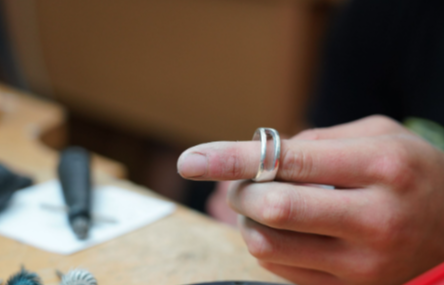Creative Uses for Jump Rings in Jewelry Making

Jump rings, those small yet versatile loops of metal, are often the unsung heroes in the world of jewelry making. While they are traditionally used for connecting components, their potential extends far beyond simple links. This blog explores some innovative and creative uses for jump rings, offering inspiration for both novice and seasoned jewelry makers to elevate their designs.
1. Chainmaille Jewelry
One of the most popular and intricate uses of jump rings is in chainmaille jewelry. Originating from the ancient art of creating armor, chainmaille involves interlocking rings to form patterns and structures. There are numerous patterns, each varying in complexity, from the simple European 4-in-1 to the more complex Japanese and Byzantine weaves. Chainmaille can be used to create stunning bracelets, necklaces, earrings, and even rings.
Getting Started with Chainmaille:
Tools: Two pairs of flat-nose pliers are essential for opening and closing the rings without distorting them.
Materials: Start with anodized aluminum or stainless steel rings for practice, as they are durable and affordable.
Patterns: Begin with basic weaves and gradually move to more complex designs. Online tutorials and chainmaille communities can provide valuable guidance.
2. Jump Ring Rosaries and Prayer Beads
Jump rings can also be creatively used to make rosaries and prayer beads. By connecting small jump rings with larger beads, you can create intricate and beautiful religious items. This method allows for a great deal of customization in terms of bead size, material, and color, making each piece unique.
Read more 5 Key Areas to Invest in Your Business for Maximum Growth
Design Tips:
Symmetry: Ensure a balanced design by using a consistent pattern and size of beads.
Durability: Use strong, closed jump rings to prevent the rosary from breaking with regular use.
Personalization: Incorporate birthstones or significant symbols for a personalized touch.
3. Floating Bead Necklaces
For a delicate and ethereal look, consider creating floating bead necklaces with jump rings. This style involves attaching beads to jump rings and then connecting these rings along a thin chain or cord. The result is a necklace where the beads appear to float, giving a light and airy feel to the piece.
Creating a Floating Bead Necklace:
Materials: Choose transparent or thin cord to enhance the floating effect.
Bead Selection: Use lightweight beads such as pearls, crystals, or small gemstones.
Spacing: Vary the spacing of the beads for an organic, natural look.
4. Geometric and Minimalist Designs
Jump rings can be used to create geometric and minimalist jewelry designs. By connecting rings in simple patterns or shapes, you can craft earrings, necklaces, and bracelets that are modern and stylish. This approach often involves using larger jump rings as the main elements of the design, sometimes combined with smaller rings for added complexity.
Design Ideas:
Earrings: Connect several rings in descending sizes to create a tiered effect.
Necklaces: Form a V-shape or hexagonal pattern with interconnected rings.
Bracelets: Combine different sizes and finishes of rings for a layered look.
5. Charm Holders
Jump rings are perfect for creating charm holders, allowing for interchangeable charms on bracelets or necklaces. By using a larger jump ring or a combination of several smaller rings, you can create a focal point that holds multiple charms. This method is ideal for those who like to switch up their jewelry frequently.
Charm Holder Tips:
Flexibility: Ensure the jump rings are large enough to accommodate the clasp of each charm.
Security: Use soldered jump rings for added strength if the piece will hold heavy or numerous charms.
Style: Choose jump rings that complement the overall aesthetic of the charms and the jewelry piece.
6. Beaded Jump Rings
Another creative use for jump rings is beading them. This involves threading small beads onto the jump ring before closing it. Beaded jump rings can be used as spacers, connectors, or even focal points in jewelry designs. They add a touch of color and texture to pieces that might otherwise be plain.
How to Bead Jump Rings:
Selection: Use small seed beads or micro beads to ensure they fit onto the jump rings.
Technique: String the beads onto the ring, then carefully close it without losing any beads.
Application: Incorporate beaded jump rings into earrings, necklaces, or as decorative elements on bracelets.
7. Tassel Attachments
Jump rings are excellent for attaching tassels to jewelry pieces. Whether you’re adding a tassel to a pair of earrings, a necklace, or a bracelet, jump rings provide a secure and flexible connection point. Tassels add a playful and dynamic element to jewelry, making them a popular choice for fashion-forward designs.
Creating Tassel Jewelry:
Materials: Use thread, silk, or leather to create tassels, depending on the desired look.
Attachment: Connect the top of the tassel to a jump ring, ensuring it is secure.
Combination: Pair tassels with beads, chains, or other decorative elements for a complete look.
8. Multi-Strand Connectors
Jump rings can be used to create multi-strand connectors for more elaborate jewelry pieces. By attaching multiple strands of chain or beads to a single jump ring, you can create layered necklaces or bracelets that have a rich, textured appearance. This method is particularly effective for statement pieces.
Multi-Strand Design Tips:
Balance: Ensure that the strands are of varying lengths for a cascading effect.
Coordination: Use jump rings that match the color and finish of the chains or beads.
Stability: Double up on jump rings for added strength if the piece is heavy.
9. Wire Wrapped Jump Rings
Enhance the look of standard jump rings by wire wrapping them. This technique involves wrapping thin wire around the jump ring, often incorporating small beads or gemstones. Wire wrapped jump rings can be used as focal points or decorative elements within a piece of jewelry.
Wire Wrapping Technique:
Materials: Use thin, flexible wire and small accent beads.
Process: Wrap the wire around the jump ring in a consistent pattern, adding beads as desired.
Incorporation: Use wire wrapped jump rings in earrings, as pendants, or as part of a bracelet design.
10. Cluster Pendants
Create cluster pendants by grouping multiple jump rings together. This can be done by connecting several rings of varying sizes and textures to form a dense, eye-catching pendant. Cluster pendants can be bold statement pieces or delicate additions to a simple chain.
Creating Cluster Pendants:
Variety: Mix different sizes, shapes, and finishes of jump rings.
Layering: Layer the rings to create depth and interest.
Attachment: Use a sturdy base ring to hold the cluster together securely.
Conclusion
Jump rings are far more than mere connectors in jewelry making. Their versatility and adaptability make them invaluable components in a wide range of creative applications. From intricate chainmaille designs to modern minimalist pieces, the possibilities are endless. By experimenting with different techniques and styles, you can discover unique and innovative ways to incorporate jump rings into your jewelry designs, elevating your creations to new heights of artistry and craftsmanship.




